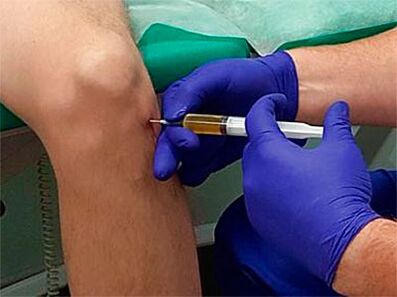Orthopedic traumatologists specialist in diagnostics (radiation, laboratory), conservative therapy (drugs, fine tuning, prop therapy, regenerative medicine, etc.) and high-tech surgical treatment of gonarthrosis (knee joint) - arthroscopy, endoprosthetics, endoprosthetics, endoprosthetics (
Gonarthrosis is observed in every tenth person over the age of 55 and causes disability in a fourth of these patients.
80% of patients with arthrosis of the knee joints report a decrease in the quality of life.
10 years after the operation, the working time of the modern knee joint endoprosthesis is 99%, after 20 years it is 95% to 95% to 90% to 90%.
Why does arthrosis of the knee joint occur?
- Most often, the reason for the development of the disease is knee injuries, especially repeated ones (meniscus, dislocations, fractures, hematomas, etc.).
- Frequent repeated microtraumas of the joint during sports training have a similar effect to constant work on your "legs".
- Excess body weight creates an increased axial load and destroys the joint.
- The joint degenerative-dystrophic process can also occur after suffering from inflammatory diseases (arthritis for gout, psoriasis, rheumatoid arthritis).
- Endocrine diseases, hormonal changes (for example, menopause), metabolic disorders aggravate pathological changes in the joint.
The main symptoms of knee joint pain
- With 1st class gonarthrosis - in the initial stage of the disease, periodic pain, after rest (walking, running, standing for a long time, standing for a long time), occurs in the joint after rest.At this stage, there is almost no joint deformity or limitation of mobility;
- Gradually, the pain becomes more frequent and occurs especially when going up and down stairs, as well as after prolonged sitting (initial pain);
- With gonarthrosis of the 2nd class, the pain in the knee during exercise is constant, it disappears only after a long rest, it disappears after the sick limb when walking;
- When moving, there is a tingling sensation in the joint.The range of movements in the knee joint is limited (when bending all the way, sharp pain appears);
- When examining the joint area, you can see swelling and deformation;
- In the first one, with severe gonarthrosis, 3rd degree doa joint that does not allow pain to fall asleep, in the range of motion, patients walk on bent legs and have a deformity of the Knee Joint (O-shaped or X-shaped legs).

Diagnostics
- An examination and examination by an orthopedic traumatologist reveals typical signs of degenerative-dystrophic joint disease (palpation, limited mobility, crepitus, deformation, exudation).
- An X-ray examination of the knee joint is performed (narrowing of the X-ray joint space, the presence of osteophytes, the presence of subchondral sclerosis) and, if necessary, a computed tomography scan of the joint.
- Ultrasound examination of the joint can detect changes in the cartilage, ligaments, muscles, soft tissues in the joint cavity, changes in the joint cavity and menisci.
- The most accurate information is provided by Knee and Arthritis Arthritis, which detects changes in the knee joint, cartilage and bone tissue, ligaments, menisci, synovial membrane, and the Knee Resonance image, which allows to distinguish tumor arthritis.
- Diagnostic puncture and arthroscopy of the knee joint, as well as laboratory testing of the synovial fluid obtained during the procedure, are widely used in the diagnosis of joint diseases.
Treatment of gonarthrosis
Treatment for arthrosis of the knee joint depends on the stage of the disease.
Conservative

In the early stages of DOA, successful complex conservative treatment is possible to reduce inflammation, restore cartilage, relieve pain and restore full joint function:
- Therapeutic and protective mode - it is necessary to jointly load the load and provide rest.
- Conservative drug treatment of gonarthrosis:
- use of analgesics, nonsteroidal anti-inflammatory drugs, chondroprotectors;
- Local use of drugs in the form of ointments, gels;
- Intra-articular injection - synovial fluid, etc.
- PRP Therapy - fine injection of Prp (own platelet-rich plasma).
- Regeneration methods - vessels of stromal-vascular fraction, cells, autologous cells of cells, cartilage tissue derived from own adipose tissue.
- Massage, physiotherapy, manual therapy.
- Mandatory use of therapeutic physical training with a set of exercises aimed at improving blood circulation in the joint and increased range of motion.
Surgical

Knee Arthroscopy
In case of changes in the joint (developed osteoarthritis, traumatic defects), orthopedic traumatologists use arthroscopy to perform surgical treatment of arthrosis of the arthrosis of the knee joint (operations on the meniscus, "joint mouse," synovectomy, etc.).
Knee arthroplasty
If other treatment methods are ineffective, we perform knee replacement using modern prostheses from the best manufacturers in the world.This is a reliable way to relieve pain and restore mobility and a decent quality of life.
Nowadays, there is no lasting result from pain and discomfort due to joint pain.Modern medical technologies allow to help with arthrosis of the knee joint at almost any stage.Contact your doctor and take advantage of the available options.



































